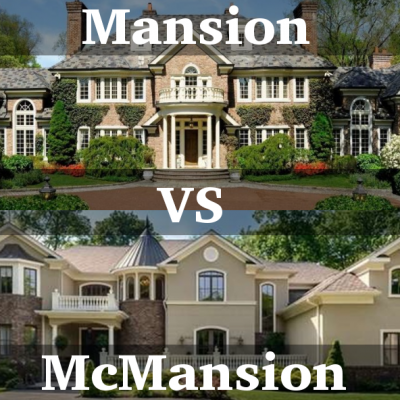
Few forms of contemporary architecture draw as much criticism as the McMansion, a particular type of oversized house that people love to hate. McMansions usually feature 3,000 or more square feet of space and fail to embody a cohesive style or interact with their environment. Kate Wagner, architecture critic and creator of McMansion Hell, is on a mission to illustrate just why these buildings seem so terrible.




Style and materials are typically good indicators that a building fits the McMansion typology. McMansions are generally “built without any sort of consideration for the grammar of design,” Wagner explains.

The structures are “too ostentatious to be considered folk architecture” and do not reflect any meaningful architectural commentary. Instead, they represent an ideal or image of wealth, if not actual wealth itself (since they are often built of cheaper materials).
That core purpose of conveying wealth effectively overrides every other potential design principle. These houses are not about history or beauty, careful symmetry or judicious asymmetry.
Wagner believes the source of their ugliness is a combination of mass-production and customization in the design process. During the 1990s and 2000s, easy access to mortgage loans led American home buyer tastes to reach new extremes.


The opulent base models of these mass-produced homes reflected that trend. But if their grand entrances, granite counters and stainless steel appliances are not enough, the structures can be further customized. The end result: a model home modded from the inside out, its exterior a confusing reflection of all kinds of small changes to interior spaces.
One victim of this inside-out design process is the roof. It may feature various pitches, odd heights, strange shapes and angles. A gabled roof here might mismatch a hipped roof there and a pyramidal roof on another part of the same home. “They are really just there to put a hat on a ridiculously crafted house,” says Wagner. Sometimes this result in weird protrusions, “where you’ll see a roofline that is relatively organized, and then you’ll just have like this ‘nub’ at the top, because somebody had to have some feature and they just couldn’t fit it in.”
 Another hallmark of many McMansions is the two-story entrance, meant to create a dramatic impression on arrival. From real estate brokers to house-flipping shows, marketers like to show these off. A big entryway, of course, calls for a big door, and perhaps a big window above. These windows are often arched on top then squared off below, a shape that is relatively unique to the McMansion.
Another hallmark of many McMansions is the two-story entrance, meant to create a dramatic impression on arrival. From real estate brokers to house-flipping shows, marketers like to show these off. A big entryway, of course, calls for a big door, and perhaps a big window above. These windows are often arched on top then squared off below, a shape that is relatively unique to the McMansion.
One unusual window might be fine, but many McMansions are riddled with various sizes and shapes of windows that fail to match or line up. While there are always thoughtful and interesting violations of any design guidelines, there are limits to what can work visually. Wagner advocates for two or fewer window shapes on a facade and a single style of window across a given floor. A proliferation of window shapes makes it increasingly hard to form a coherent architectural design.


Many McMansions would also not be complete without columns, often oversized or undersized relative to their apparent structural purpose. In theory, a set of columns should physically and visually balance the thing they are holding up. Wagner notes that “if you have these really big columns and they are holding up the tiniest little pediment or portico it looks like pretty ridiculous.” Big columns conjure images of wealth (like banks) and power (like state capital buildings).
All of this snarky criticism is entertaining, but there is also a larger point to be made about the design of the McMansion. According to Wagner, they are indicative of a larger shift in thinking: a house is no longer a place that we live in (potentially for the rest of our lives) but rather an asset that we are decidedly not supposed to live in forever.

Accordingly, people started designing their houses not just for themselves but with a future sale in mind. Wagner lays the blame for this mindset at the feet of HGTV and similar channels.
The excesses of the McMansion were reinforced over and over again on home improvement and house-flipping television shows. These programs convinced people there were always ways to make an abode better and (crucially) more valuable when it goes on the market.




“Home improvement channels would paint a house beige and then you would see this ticker in the corner that says ‘oh we just added $800 to the value of this house’,” laments Wagner. “They would come up with these crazy way just to quantify these sort of improvements.”

While McMansions may be stylistically diverse, many also share similar elements, like granite counters or a certain color of paint or shade of wood. And these superficial changes are not actually as valuable in the long run as structural improvements or energy efficiency upgrades.




Meanwhile, there are countervailing trends as well. Small-space living and tiny house movements have begun to take off, partly out of economic necessity but also in response to excessive architecture. Aside from livability, there is real concern that McMansions are a bad investment. Other people are choosing a middle path, building homes that suit their needs and opting to put money in quality design and materials. Despite all of this, the popularity of McMansions is picking up again as well – we have not seen the end of this.
It would be easy to chalk up the more aesthetic elements of McMansions to matters of opinion, but different styles are more than just fashion statements. They give people a sense of place, evolving through a combination of taste, location and necessity, and “that’s why you’ll see like Pueblo style architecture in the West” explains Wagner, rather than, say, Cary, North Carolina. “It’s just one of those things that gives you a context of where you are … the built environment has everything to do with place [just] as the natural environment does.”
Embedded in the pages of McMansion Hell are lessons in consumerism and materialism, but also illustrated stories about the fundamentals of architecture, including and beyond columns and windows. The website uses humor to explain basic principles of architectural design and history in a more entertaining and engaging way than a textbook.
McMansion Hell also gives voice to gut reactions, those intuitive senses of what is “good” or “bad” about buildings that people find hard to articulate. Wagner gets a good deal of fan mail, thanking her for her efforts. “So now people can say now I know why I hate that house. And it is empowering people to have opinions about the built environment, which they have mostly been served through a marketing or materialistic lens rather than from a design standpoint.” And now, thanks to her endeavor, we can all suffer together, seeing and sharing those horrible structures. Hell may well be other people’s McMansions.







































 Photo by Keith Smith.
Photo by Keith Smith. Photo by Keith Smith.
Photo by Keith Smith. Photo by Keith Smith.
Photo by Keith Smith. Photo by Keith Smith.
Photo by Keith Smith. Photo by Keith Smith.
Photo by Keith Smith.














